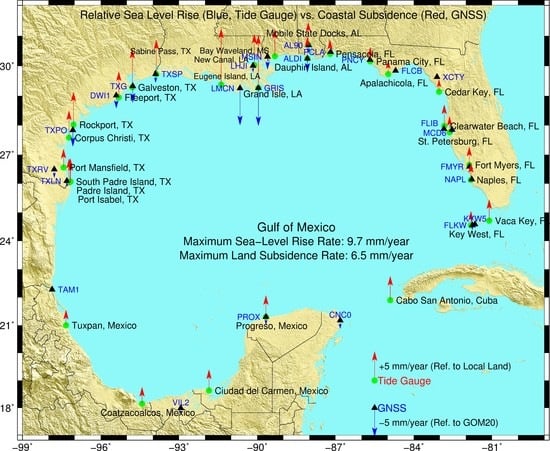GOM20: A Stable Geodetic Reference Frame for Subsidence, Faulting, and Sea-Level Rise Studies along the Coast of the Gulf of Mexico
Abstract
1. Introduction
2. Continuous GNSS Stations within the GOM Region
3. Realization of GOM20
3.1. Reference Stations
- (1)
- distance within 500 km to the GOM coastline;
- (2)
- having over 2400 daily files and spanning over at least eight years;
- (3)
- active through 2019 with a continuous segment of minimum 5 years;
- (4)
- outside of known subsiding or fault-creeping areas.
3.2. Coordinate Transformation from IGS14 to GOM20
3.3. Stability of GOM20
4. Applications of GOM20
4.1. Urban Subsidence
4.2. Coastal Subsidence and Faulting
4.3. Delineating the Absolute Sea-level Rise Rate along the GOM Coast
5. Discussion
5.1. GOM20 Versus NAVD88
5.2. GOM20 Versus NA12
5.3. Broad Applications of GOM20
6. Conclusions
Author Contributions
Funding
Acknowledgments
Conflicts of Interest
Appendix A
| Reference GNSS | Location (Degree) | Observational History | *Site Velocity (mm/year) | ||||||
|---|---|---|---|---|---|---|---|---|---|
| Longitude | Latitude | Start | End | Years | Days | EW | NS | UD** | |
| AL20 | −87.6627 | 34.7103 | 2006.6 | 2018.5 | 11.9 | 4154 | −0.11 | −0.09 | 0.68 |
| AL55 | −87.6156 | 32.7115 | 2010.5 | 2019.9 | 9.4 | 3199 | −0.19 | 0.00 | −0.01 |
| AL60 | −86.2706 | 32.4114 | 2007.0 | 2019.9 | 12.9 | 4607 | −0.06 | −0.03 | −0.89 |
| AL76 | −85.2257 | 31.8750 | 2011.2 | 2019.9 | 8.7 | 3127 | −0.36 | −0.03 | −0.94 |
| ALA1 | −85.5039 | 32.5989 | 2010.5 | 2019.9 | 9.4 | 3392 | −0.02 | 0.13 | 0.24 |
| ALCN | −85.6586 | 34.1631 | 2010.6 | 2019.9 | 9.3 | 3379 | −0.33 | −0.06 | 0.29 |
| ALCU | −86.8449 | 34.1799 | 2010.7 | 2019.9 | 9.2 | 3321 | −0.01 | 0.05 | 0.34 |
| ALFA | −87.8293 | 33.6852 | 2010.5 | 2019.9 | 9.4 | 3380 | −0.30 | −0.57 | −0.29 |
| ALTA | −86.1212 | 33.4235 | 2010.7 | 2019.9 | 9.2 | 3343 | −0.03 | 0.21 | −0.47 |
| ARCM | −92.8827 | 33.5424 | 2005.6 | 2019.9 | 14.3 | 5043 | −0.06 | 0.10 | −0.49 |
| ARLR | −92.3826 | 34.6726 | 2005.6 | 2019.9 | 14.3 | 5099 | 0.03 | −0.05 | 0.08 |
| BKVL | −82.4537 | 28.4738 | 2003.6 | 2019.9 | 16.3 | 4814 | −0.38 | 0.03 | 0.54 |
| COLA | −81.1217 | 34.0810 | 1999.0 | 2019.9 | 20.9 | 7137 | −0.21 | 0.60 | 0.11 |
| FLKW | −81.7543 | 24.5537 | 2002.9 | 2019.9 | 17.0 | 3948 | 0.38 | 0.12 | −0.23 |
| FMYR | −81.8642 | 26.5910 | 2004.2 | 2019.9 | 15.7 | 4996 | −0.07 | 0.36 | −0.59 |
| GACC | −82.1338 | 33.5458 | 2003.9 | 2019.9 | 16.0 | 5253 | −0.56 | 0.32 | 0.64 |
| GACR | −83.3462 | 32.3810 | 2005.4 | 2019.9 | 14.5 | 4379 | −0.33 | −0.21 | 0.34 |
| GACU | −84.1251 | 34.2116 | 2010.0 | 2019.9 | 9.9 | 3509 | −0.71 | −0.35 | −0.09 |
| GANW | −84.7674 | 33.3058 | 2005.2 | 2019.9 | 14.7 | 4897 | 0.10 | −0.57 | 0.85 |
| GNVL | −82.2769 | 29.6866 | 2002.4 | 2019.9 | 17.5 | 5714 | −0.22 | −0.09 | 0.48 |
| LCLU | −97.6607 | 29.7321 | 2010.0 | 2019.9 | 9.9 | 3437 | −0.31 | 0.45 | −0.78 |
| MSEV | −89.2037 | 31.5950 | 2012.2 | 2019.9 | 7.7 | 2792 | −0.32 | 0.01 | −0.76 |
| MSME | −88.7325 | 32.3675 | 2006.6 | 2019.9 | 13.3 | 4635 | 0.01 | 0.05 | −0.42 |
| MSNA | −91.4046 | 31.5612 | 2008.2 | 2019.9 | 11.7 | 3575 | −0.06 | 0.04 | 0.30 |
| MSOX | −89.5324 | 34.3642 | 2008.6 | 2019.9 | 11.3 | 4077 | −0.02 | −0.15 | −0.64 |
| MTY2 | −100.3129 | 25.7155 | 2005.7 | 2019.9 | 14.2 | 5010 | 0.14 | 0.55 | −0.25 |
| OKAN | −95.6214 | 34.1952 | 2002.6 | 2019.9 | 17.3 | 5055 | −0.06 | −0.24 | −0.37 |
| OKAR | −97.1693 | 34.1685 | 2004.9 | 2019.9 | 15.0 | 4718 | −0.30 | −0.28 | −0.23 |
| OKCB | −80.8553 | 27.2660 | 2002.9 | 2019.9 | 17.0 | 5364 | −0.19 | 0.07 | 0.08 |
| ORMD | −81.1089 | 29.2982 | 2003.3 | 2019.9 | 16.6 | 5086 | −0.09 | −0.14 | 0.75 |
| PBCH | −80.2193 | 26.8463 | 2005.2 | 2019.9 | 14.7 | 4824 | −0.16 | 0.21 | 0.85 |
| TAM1 | −97.8640 | 22.2783 | 2005.0 | 2019.9 | 14.9 | 4374 | 0.48 | 0.34 | 0.17 |
| TXAA | −94.1535 | 33.1136 | 2010.6 | 2019.4 | 8.9 | 3154 | 0.23 | −0.08 | −0.42 |
| TXAB | −99.7568 | 32.5033 | 2005.1 | 2019.9 | 14.8 | 5235 | 0.55 | 0.12 | 0.29 |
| TXDC | −97.6087 | 33.2362 | 2005.7 | 2019.9 | 14.2 | 5102 | 0.36 | 0.05 | −0.47 |
| TXEP | −100.4775 | 28.7083 | 2010.5 | 2019.9 | 9.4 | 3387 | 0.66 | 0.52 | 0.82 |
| TXFE | −98.6174 | 27.8467 | 2010.6 | 2019.9 | 9.3 | 3287 | 0.84 | 0.18 | 0.54 |
| TXFR | −98.8468 | 30.2460 | 2005.6 | 2019.9 | 14.3 | 5181 | −0.05 | 0.31 | 0.18 |
| TXGT | −97.7080 | 31.4326 | 2010.7 | 2019.4 | 8.8 | 3125 | 0.19 | −0.09 | 0.16 |
| TXHO | −99.1345 | 29.3439 | 2007.8 | 2019.9 | 12.1 | 4389 | −0.17 | 0.45 | −0.53 |
| TXLF | −94.7183 | 31.3564 | 2005.6 | 2019.9 | 14.3 | 5189 | 0.32 | −0.21 | −0.63 |
| TXLL | −98.6786 | 30.7335 | 2005.6 | 2019.9 | 14.3 | 5191 | 0.25 | 0.33 | −0.46 |
| TXLR | −99.4479 | 27.5139 | 2002.1 | 2019.9 | 17.8 | 6251 | −0.30 | 0.14 | 0.64 |
| TXMA | −94.2886 | 32.5353 | 2005.6 | 2019.9 | 14.3 | 5180 | 0.25 | 0.61 | −0.65 |
| TXMI | −95.4770 | 32.6893 | 2010.6 | 2019.4 | 8.9 | 2958 | 0.17 | −0.13 | −0.81 |
| TXNA | −96.5388 | 32.0418 | 2003.8 | 2019.9 | 16.1 | 5631 | −0.02 | 0.35 | −0.05 |
| TXSA | −100.4729 | 31.4143 | 2003.6 | 2019.9 | 16.3 | 5743 | 0.04 | 0.29 | 0.45 |
| TXSN | −102.4095 | 30.1526 | 2005.6 | 2019.9 | 14.3 | 5166 | 0.18 | 0.19 | −0.11 |
| TXST | −98.1822 | 32.2326 | 2005.7 | 2019.9 | 14.2 | 5126 | 0.14 | 0.02 | −0.51 |
| TXTH | −99.1679 | 33.1790 | 2009.4 | 2019.9 | 10.5 | 3829 | 0.18 | −0.21 | 0.65 |
| WACH | −81.8824 | 27.5142 | 2005.3 | 2019.9 | 14.6 | 4344 | −0.08 | 0.11 | −0.30 |
| XCTY | −83.1082 | 29.6310 | 2004.1 | 2019.9 | 15.8 | 4922 | −0.10 | −0.10 | 0.55 |
| ZEFR | −82.1646 | 28.2276 | 2003.7 | 2019.7 | 16.1 | 5317 | −0.24 | −0.22 | 0.10 |
| ZJX1 | −81.9082 | 30.6989 | 2002.5 | 2019.9 | 17.4 | 5809 | −0.23 | −0.16 | 0.21 |
| ZMA1 | −80.3192 | 25.8246 | 2004.0 | 2019.9 | 15.9 | 5840 | −0.01 | 0.05 | −0.29 |
| Root Mean Square (RMS): | 13.5 | 4508 | 0.3 | 0.3 | 0.5 | ||||
References
- Dixon, T.H.; Amelung, F.C.; Ferretti, A.; Novali, F.; Rocca, F.; Dokka, R.; Whitman, D. Space geodesy: Subsidence and flooding in New Orleans. Nature 2006, 441, 587–588. [Google Scholar] [CrossRef]
- Kolker, A.S.; Allison, M.A.; Hameed, S. An evaluation of subsidence rates and sea-level variability in the northern Gulf of Mexico. Geophys. Res. Lett. 2011, 38, L21404. [Google Scholar] [CrossRef]
- Olea, R.A.; Coleman, J.L. A synoptic examination of causes of land loss in southern Louisiana as related to the exploitation of subsurface geologic resources. J. Coast. Res. 2014, 30, 1025–1044. [Google Scholar] [CrossRef]
- Karegar, M.A.; Dixon, T.H.; Malservisi, R. A three dimensional surface velocity field for the Mississippi Delta: Implications for coastal restoration and flood potential. Geology 2015, 43, 519–522. [Google Scholar] [CrossRef]
- Dokka, R.K. Modern-day tectonic subsidence in coastal Louisiana. Geology 2006, 34, 281–284. [Google Scholar] [CrossRef]
- Dokka, R.K.; Sella, G.F.; Dixon, T.H. Tectonic control of subsidence and southward displacement of southeast Louisiana with respect to stable North America. Geophys. Res. Lett. 2006, 33, L23308. [Google Scholar] [CrossRef]
- Yuill, B.; Lavoie, D.; Reed, D.J. Understanding subsidence processes in coastal Louisiana. J. Coast. Res. 2009, 23–36. [Google Scholar] [CrossRef]
- Engelkemeir, R.; Khan, S.D.; Burke, K. Surface deformation in Houston, Texas using GPS. Tectonophysics 2010, 490, 47–54. [Google Scholar] [CrossRef]
- Liu, Y.; Sun, X.; Wang, G.; Turco, M.J.; Agudelo, G.; Bao, Y.; Zhao, R.; Shen, S. Current activity of the Long Point Fault in Houston, Texas constrained by continuous GPS measurements (2013–2018). Remote Sens. 2019, 11, 1213. [Google Scholar] [CrossRef]
- Hammar-Klose, E.S.; Thieler, E.R. Coastal Vulnerability to Sea-Level Rise: A Preliminary Database for the U.S. Atlantic, Pacific and Gulf of Mexico Coasts; United States Geological Survey: Reston, VA, USA, 2001; p. 68. Available online: https://pubs.usgs.gov/dds/dds68/ (accessed on 18 January 2020).
- Yu, J.; Wang, G. Introduction to the GNSS geodetic infrastructure in the Gulf of Mexico Region. Surv. Rev. 2017, 352, 51–65. [Google Scholar] [CrossRef]
- Rebischung, P.; Altamimi, Z.; Ray, J.; Garayt, B. The IGS contribution to ITRF2014. J. Geod. 2016, 90, 611–630. [Google Scholar] [CrossRef]
- DeMets, C.; Gordon, R.G.; Argus, D.F. Geologically current plate motions. Geophy. J. Intl. 2010, 181, 1–80. [Google Scholar] [CrossRef]
- Wang, G.; Soler, T. Using OPUS for measuring vertical displacements in Houston, Texas. J. Surv. Eng. 2013, 139, 126–134. [Google Scholar] [CrossRef]
- Yang, L.; Wang, G.; Bao, Y.; Kearns, T.J.; Yu, J. Comparisons of ground-based and building-based CORS: A case study in the region of Puerto Rico and the Virgin Islands. J. Surv. Eng. 2015, 142, 05015006. [Google Scholar] [CrossRef]
- Zumberge, J.F.; Heflin, M.B.; Jefferson, D.C.; Watkins, M.M.; Webb, F.H. Precise point positioning for the efficient and robust analysis of GPS data from large networks. J. Geophys. Res. 1997, 102, 5005–5017. [Google Scholar] [CrossRef]
- Bertiger, W.; Desai, S.D.; Haines, B.; Harvey, N.; Moore, A.W.; Owen, S.; Weiss, J.P. Single receiver phase ambiguity resolution with GPS data. J. Geod. 2010, 84, 327–337. [Google Scholar] [CrossRef]
- Blewitt, G.; Hammond, W.C.; Kreemer, C. Harnessing the GPS data explosion for interdisciplinary science. EOS 2018, 99. [Google Scholar] [CrossRef]
- Herring, T.A.; Melbourne, T.I.; Murray, M.H.; Floyd, M.A.; Szeliga, W.M.; King, R.W.; Phillips, D.A.; Puskas, C.M.; Santillan, M.; Wang, L. Plate Boundary Observatory and related networks: GPS data analysis methods and geodetic products. Rev. Geophys. 2016, 54, 759–808. [Google Scholar] [CrossRef]
- Wang, G. Millimeter-accuracy GPS landslide monitoring using precise point positioning with single receiver phase ambiguity resolution: A case study in Puerto Rico. J. Geod. Sci. 2013, 3, 22–31. [Google Scholar] [CrossRef]
- Wang, G.; Bao, Y.; Cuddus, Y.; Jia, X.; Serna, J.; Jing, Q. A methodology to derive precise landslide displacement time series from continuous GPS observations in tectonically active and cold regions: A case study in Alaska. Nat. Hazards 2015, 77, 1939–1961. [Google Scholar] [CrossRef]
- Bao, Y.; Guo, W.; Wang, G.; Gan, W.; Zhang, M.; Shen, J.S. Millimeter-accuracy structural deformation monitoring using stand-alone GPS: Case study in Beijing, China. J. Surv. Eng. 2017, 144, 05017007. [Google Scholar] [CrossRef]
- Guo, W.; Wang, G.; Bao, Y.; Li, P.; Zhang, M.; Gong, Q.; Li, R.; Gao, Y.; Zhao, R.; Shen, S. Detection and monitoring of tunneling-induced riverbed deformation using GPS and BeiDou: A case study. Appl. Sci. 2019, 9, 2759. [Google Scholar] [CrossRef]
- Altamimi, Z.; Rebischung, P.; Métivier, L.; Collilieux, X. ITRF2014. A new release of the International Terrestrial Reference Frame modeling nonlinear station motions. J. Geophys. Res. 2016, 121, 6109–6131. [Google Scholar] [CrossRef]
- Yang, L.; Wang, G.; Huérfano, V.; Hillebrandt-Andrade, C.G.; Martínez-Cruzado, J.A.; Liu, H. GPS geodetic infrastructure for natural hazards study in the Puerto Rico and Virgin Islands region. Nat. Hazards 2016, 83, 641–665. [Google Scholar] [CrossRef]
- Qu, F.; Lu, Z.; Zhang, Q.; Bawden, G.W.; Kim, J.W.; Zhao, C.; Qu, W. Mapping ground deformation over Houston–Galveston, Texas using multi-temporal InSAR. Remote Sens. Environ. 2015, 169, 290–306. [Google Scholar] [CrossRef]
- Qu, F.; Lu, Z.; Kim, J.W.; Zheng, W. Identify and monitor growth faulting using InSAR over northern Greater Houston, Texas, USA. Remote Sens. 2019, 11, 1498. [Google Scholar] [CrossRef]
- Zhou, X.; Wang, G.; Bao, Y.; Xiong, L.; Guzman, V.; Kearns, T.J. Delineating beach and dune morphology from massive Terrestrial Laser Scanning data using Generic Mapping Tools. J. Surv. Eng. 2017, 143, 04017008. [Google Scholar] [CrossRef]
- Xiong, L.; Wang, G.; Wessel, P. Anti-aliasing filters for deriving high-accuracy DEMs from TLS data: A case study from Freeport, Texas. Comp. Geosci. 2017, 100, 125–134. [Google Scholar] [CrossRef]
- Xiong, L.; Wang, G.; Bao, Y.; Zhou, X.; Wang, K.; Liu, H.; Sun, X.; Zhao, R. A Rapid Terrestrial Laser Scanning method for coastal erosion studies: A case study at Freeport, Texas, USA. Sensors 2019, 19, 3252. [Google Scholar] [CrossRef]
- Wang, G.; Yu, J.; Ortega, J.; Saenz, G.; Burrough, T.; Neill, R. A stable reference frame for the study of ground deformation in the Houston metropolitan area, Texas. J. Geod. Sci. 2013, 3, 188–202. [Google Scholar] [CrossRef]
- Yu, J.; Wang, G. GPS-derived ground deformation (2005–2014) within the Gulf of Mexico region referred to a stable Gulf of Mexico reference frame. Nat. Hazards. Earth Syst. Sci. 2016, 16, 1583–1602. [Google Scholar] [CrossRef]
- Wang, G.; Liu, H.; Mattioli, G.S.; Miller, M.M.; Feaux, K.; Braun, J. CARIB18: A stable geodetic reference frame for geological hazard monitoring in the Caribbean region. Remote Sens. 2019, 11, 680. [Google Scholar] [CrossRef]
- Blewitt, G.; Kreemer, C.; Hammond, W.C.; Goldfarb, J.M. Terrestrial reference frame NA12 for crustal deformation studies in North America. J. Geodyn. 2013, 72, 11–24. [Google Scholar] [CrossRef]
- Wang, G.; Bao, Y.; Gan, W.; Geng, J.; Xiao, G.; Shen, J.S. NChina16: A stable geodetic reference frame for geological hazard studies in North China. J. Geodyn. 2018, 115, 10–22. [Google Scholar] [CrossRef]
- Kearns, T.J.; Wang, G.; Turco, M.; Welch, J.; Tsibanos, V.; Liu, H. Houston16: A stable geodetic reference frame for subsidence and faulting study in the Houston metropolitan area, Texas, US. Geod. Geodyn. 2019, 10, 382–393. [Google Scholar] [CrossRef]
- Wang, G.; Soler, T. Measuring land subsidence using GPS: Ellipsoid height vs. orthometric height. J. Surv. Eng. 2014, 141, 1–12. [Google Scholar] [CrossRef]
- Wang, G.; Turco, M.; Soler, T.; Kearns, T.; Welch, J. Comparisons of OPUS and PPP solutions for subsidence monitoring in the greater Houston area. J. Surv. Eng. 2017, 143, 05017005. [Google Scholar] [CrossRef]
- Kearns, T.J.; Wang, G.; Bao, Y.; Jiang, J.; Lee, D. Current land subsidence and groundwater level changes in the Houston metropolitan area, Texas (2005–2012). J. Surv. Eng. 2015, 05015002, 1–16. [Google Scholar] [CrossRef]
- Wang, G.; Yu, J.; Kearns, T.J.; Ortega, J. Assessing the accuracy of long-term subsidence derived from borehole extensometer data using GPS observations: Case study in Houston, Texas. J. Surv. Eng. 2014, 140, 5014001. [Google Scholar] [CrossRef]
- Yu, J.; Wang, G.; Kearns, T.J.; Yang, L. Is there deep- seated subsidence in the Houston-Galveston area? Int. J. Geophys. 2014, 1–11. [Google Scholar] [CrossRef]
- Kasmarek, M.C.; Ramage, J.K. Water-level altitudes 2017 and water-level changes in the Chicot, Evangeline, and Jasper aquifers and compaction 1973–2016 in the Chicot and Evangeline aquifers, Houston Galveston region, Texas. U.S. Geol. Surv. Sci. Investig. Rep. 2017, 5080. [Google Scholar] [CrossRef]
- Shah, S.D.; Ramage, J.K.; Braun, C.L. Status of groundwater-level altitudes and long-term groundwater-level changes in the Chicot, Evangeline, and Jasper aquifers, Houston-Galveston region, Texas, 2018. U.S. Geol. Surv. Sci. Investig. Rep. 2018, 5101. [Google Scholar] [CrossRef]
- Blewitt, G.; Kreemer, C.; Hammond, W.C.; Gazeaux, J. MIDAS robust trend estimator for accurate GPS station velocities without step detection. J. Geophys. Res. 2016, 121, 2054–2068. [Google Scholar] [CrossRef] [PubMed]
- Williams, S.D.P.; Bock, Y.; Fang, P.; Jamason, P.; Nikolaidis, R.M.; Prawirodirdjo, L.; Miller, M.; Johnson, D.J. Error analysis of continuous GPS position time series. J. Geophys. Res. 2004, 109, B03412. [Google Scholar] [CrossRef]
- Manea, V.C.; Marina, M.; Ferrari, L. A geodynamical perspective on the subduction of Cocos and Rivera plates beneath Mexico and Central America. Tectonophysics 2013, 609, 56–81. [Google Scholar] [CrossRef]
- Turco, M.J.; Petrov, A. Effects of groundwater regulation on aquifer-system compaction and subsidence in the Houston-Galveston Region, Texas, USA. Proc. IAHS 2015, 372, 511–514. [Google Scholar] [CrossRef]
- Khan, S.D.; Huang, Z.; Karacay, A. Study of ground subsidence in northwest Harris county using GPS, LiDAR, and InSAR techniques. Nat. Hazards 2014, 73, 1143–1173. [Google Scholar] [CrossRef]
- Wang, G.; Welch, J.; Kearns, T.J.; Yang, L.; Serna, J. Introduction to GPS geodetic infrastructure for land subsidence monitoring in Houston, Texas, USA. Proc. IAHS 2015, 372, 297–303. [Google Scholar] [CrossRef][Green Version]
- Castellazzi, P.; Arroyo-Dominguez, N.; Martel, R.; Calderhead, A.I.; Normand, J.C.L.; Garfias, J.; Rivera, A. Land subsidence in major cities of central Mexico: Interpreting InSAR-derived land subsidence mapping with hydrogeological data. Int. J. Appl. Earth Obs. Geéoinf. 2016, 47, 102–111. [Google Scholar] [CrossRef]
- Pacheco-Martínez, J.; Hernandez-Marín, M.; Burbey, T.J.; González-Cervantes, N.; Ortíz-Lozano, J.A.; Zermeño-De-Leon, M.E.; Solís-Pinto, A. Land subsidence and ground failure associated to groundwater exploitation in the Aguascalientes valley, Mexico. Eng. Geol. 2013, 164, 172–186. [Google Scholar] [CrossRef]
- Chaussard, E.; Wdowinski, S.; Cabral-Cano, E.; Amelung, F. Land subsidence in Central Mexico detected by ALOS InSAR time-series. Remote Sens. Environ. 2014, 140, 94–106. [Google Scholar] [CrossRef]
- Du, Z.; Ge, L.; Ng, A.M.; Zhu, Q.; Zhang, Q.; Kuang, J.; Dong, Y. Long-term subsidence in Mexico City from 2004 to 2018 revealed by five synthetic aperture radar sensors. Land Degrad. Dev. 2019, 30, 1785–1801. [Google Scholar] [CrossRef]
- Neely, W.R.; Borsa, A.A.; Silverii, F. GInSAR: A cGPS correction for enhanced InSAR time series. IEEE Tran. Geosci. Remote Sensci. 2019. [Google Scholar] [CrossRef]
- Day, J.W.; Boesch, D.F.; Clairain, E.J.; Kermp, G.P.; Laska, S.B.; Mitsch, W.J.; Orth, K. Restoration of the Mississippi Delta: Lessons from Hurricanes Katrina and Rita. Science 2007, 315, 1679–1684. [Google Scholar] [CrossRef]
- Morton, R.A.; Buster, N.A.; Krohn, M.D. Subsurface controls on historical subsidence rates and associated wetland loss in southcentral Louisiana. Gulf Coast Assoc. Geol. Soc. Trans. 2002, 52, 767–778. Available online: http://pubs.er.usgs.gov/publication/70123287 (accessed on 18 January 2020).
- AAPG-American Association of Petroleum Geologists. Salt tectonism of the U.S. Gulf Coast basin (CD-ROM), Geographic Information Systems–Up stream Digital Reference Information Library (GIS-UDRIL). 2011. Tulsa, Oklahoma. Available online: http://datapages.com/associated-websites/documents/gisudrilbrochurejan2013 (accessed on 18 January 2020).
- Törnqvist, T.E.; Wallace, D.J.; Storms, J.E.A. Mississippi Delta subsidence primarily caused by compaction of Holocene strata. Nat. Geosci. 2008, 1, 173–176. [Google Scholar] [CrossRef]
- Yu, S.Y.; Törnqvist, T.E.; Hu, P. Quantifying Holocene lithospheric subsidence rates underneath the Mississippi Delta. Earth and Planet. Sci. Lett. 2012, 331, 21–30. [Google Scholar] [CrossRef]
- Blum, M.D.; Roberts, H.H. The Mississippi delta region: Past, present, and future. Ann. Revi. Earth Planet. Sci. 2012, 40, 655–683. [Google Scholar] [CrossRef]
- Wolstencroft, M.; Shen, Z.; Törnqvist, T.E.; Milne, G.A.; Kulp, M. Understanding subsidence in the Mississippi Delta region due to sediment, ice, and ocean loading: Insights from geophysical modeling. J. Geophy. Res. Solid Earth 2014, 119, 3838–3856. [Google Scholar] [CrossRef]
- Higgins, S.A. Advances in delta-subsidence research using satellite methods. Hydrogeol. J. 2016, 24, 587–600. [Google Scholar] [CrossRef]
- Kreemer, C.; Hammond, W.C.; Blewitt, G. A robust estimation of the 3-D intraplate deformation of the North American plate from GPS. J. Geophys. Res. Solid Earth 2018, 123, 4388–4412. [Google Scholar] [CrossRef]
- Galloway, D.L.; Erkens, G.; Kuniansky, E.L.; Rowland, J.C. Land subsidence processes. Hydrogeol. J. 2016, 24, 547–550. [Google Scholar] [CrossRef]
- Nicholls, R.J.; Cazenave, A. Sea-level rise and its impact on coastal zones. Science 2010, 328, 1517–1520. [Google Scholar] [CrossRef] [PubMed]
- Jankowski, K.L.; Törnqvist, T.E.; Fernandes, A.M. Vulnerability of Louisiana’s coastal wetlands to present-day rates of relative sea-level rise. Nat. Commun. 2017, 8, 14792. [Google Scholar] [CrossRef]
- Nienhuis, J.H.; Törnqvist, T.E.; Jankowski, K.L.; Fernandes, A.M.; Keogh, M.E. A new subsidence map for coastal Louisiana. GSA Today 2017, 27, 58–59. [Google Scholar] [CrossRef]
- Keogh, M.E.; Törnqvist, T.E. Measuring rates of present-day relative sea-level rise in low-elevation coastal zones: A critical evaluation. Ocean Sci. 2019, 15, 61–73. [Google Scholar] [CrossRef]
- Cahoon, D.R. Estimating relative sea-level rise and submergence potential at a coastal wetland. Estuar. Coast. 2015, 38, 1077–1084. [Google Scholar] [CrossRef]
- Zervas, C. Sea level variations of the United States 1854–2006, NOAA Technical Report NOS CO-OPS 053, NOAA National Ocean Service Center for Operational Oceanographic Products and Services. 2009. Available online: https://repository.library.noaa.gov/view/noaa/2565 (accessed on 18 January 2020).
- Holgate, S.J. On the decadal rates of sea level change during the twentieth century. Geophys. Res. Lett. 2007, 34, L01602. [Google Scholar] [CrossRef]
- Jevrejeva, S.; Moore, J.C.; Grinsted, A.; Woodworth, P.L. Recent global sea level acceleration started 200 years ago? Geophys. Res. Lett. 2008, 35, L08715. [Google Scholar] [CrossRef]
- Wenzel, M.; Schroter, J. Reconstruction of regional mean sea level anomalies from tide gauges using neural networks. J. Geophys. Res. 2010, 115, C08013. [Google Scholar] [CrossRef]
- Church, J.A.; White, N.J. Sea-level rise from the late 19th to the early 21st Century. Surv. Geophy. 2011, 32, 585–602. [Google Scholar] [CrossRef]
- Ray, R.D.; Douglas, B.C. Experiments in reconstructing twentieth-century sea levels. Prog. Oceanogr. 2011, 91, 496–515. [Google Scholar] [CrossRef]
- Hay, C.C.; Morrow, E.; Kopp, R.E.; Mitrovica, J.X. Probabilistic reanalysis of twentieth-century sea-level rise. Nature 2015, 517, 481–484. [Google Scholar] [CrossRef] [PubMed]
- Letetrel, C.; Karpytchev, M.; Bouin, M.N.; Marcos, M.; SantamarÍa-Gómez, A.; Wöppelmann, G. Estimation of vertical land movement rates along the coasts of the Gulf of Mexico over the past decades. Cont. Shelf Res. 2015, 111, 42–51. [Google Scholar] [CrossRef]
- Pearson, C.; Snay, R. IntroducingHTDP3.1 to transform coordinates across time and spatial reference frames. GPS Solu. 2013, 17, 1–17. [Google Scholar] [CrossRef]
- Peltier, W.R.; Argus, D.F.; Drummond, R. Space geodesy constrains ice age terminal deglaciation: The global ICE-6G_C (VM5a) model. J. Geophy. Res. Solid Earth 2014, 120, 450–487. [Google Scholar] [CrossRef]

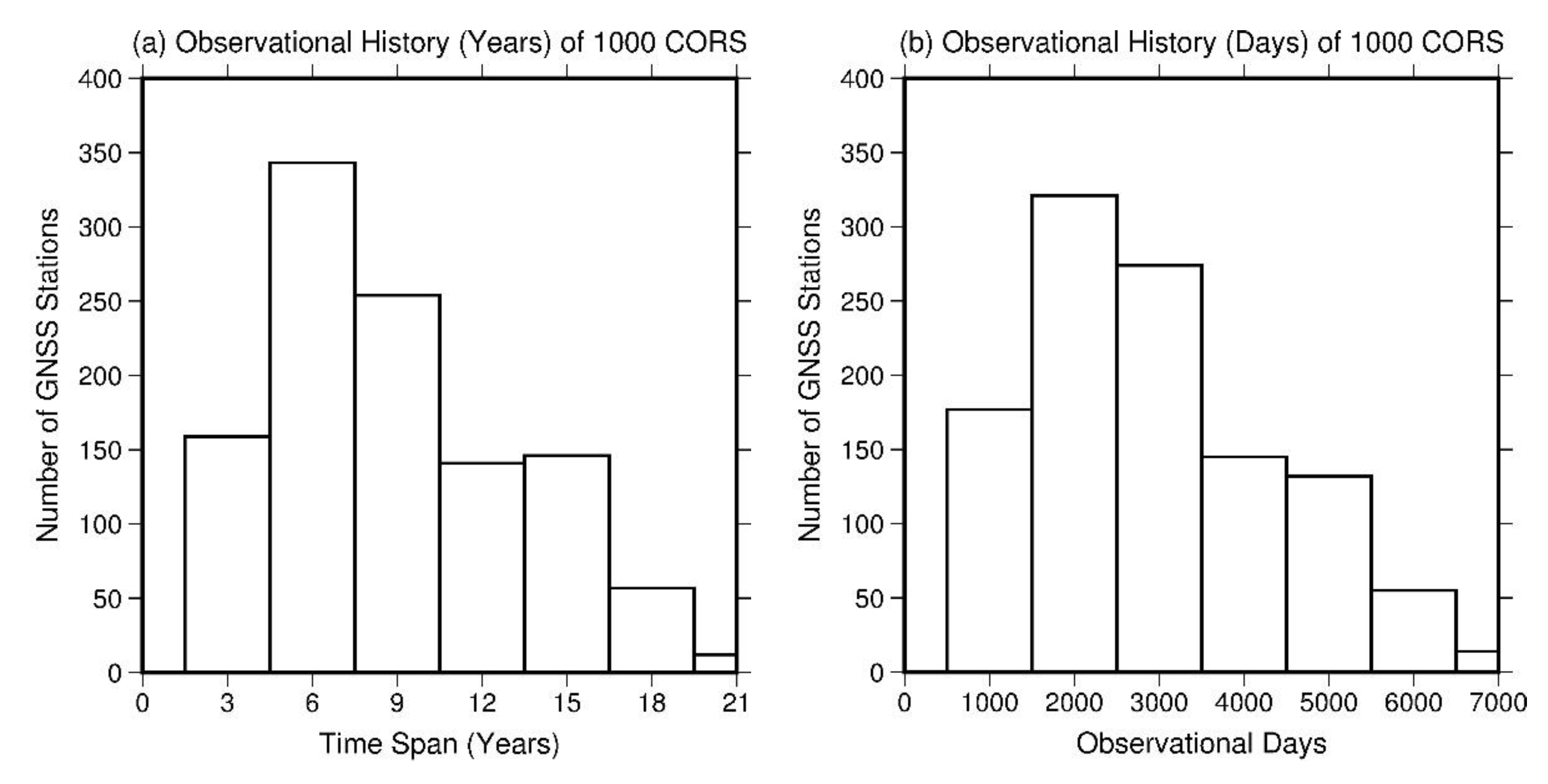
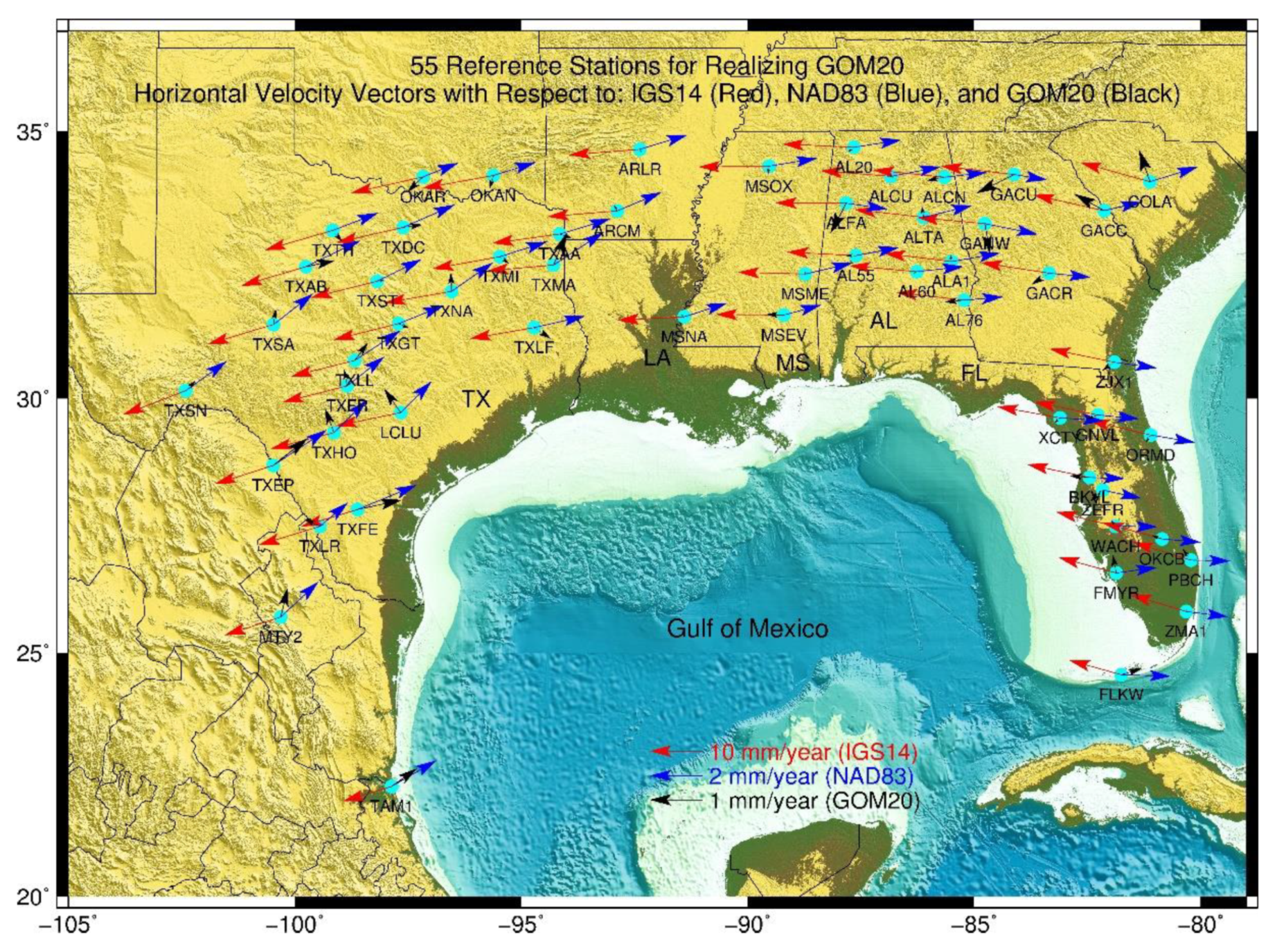
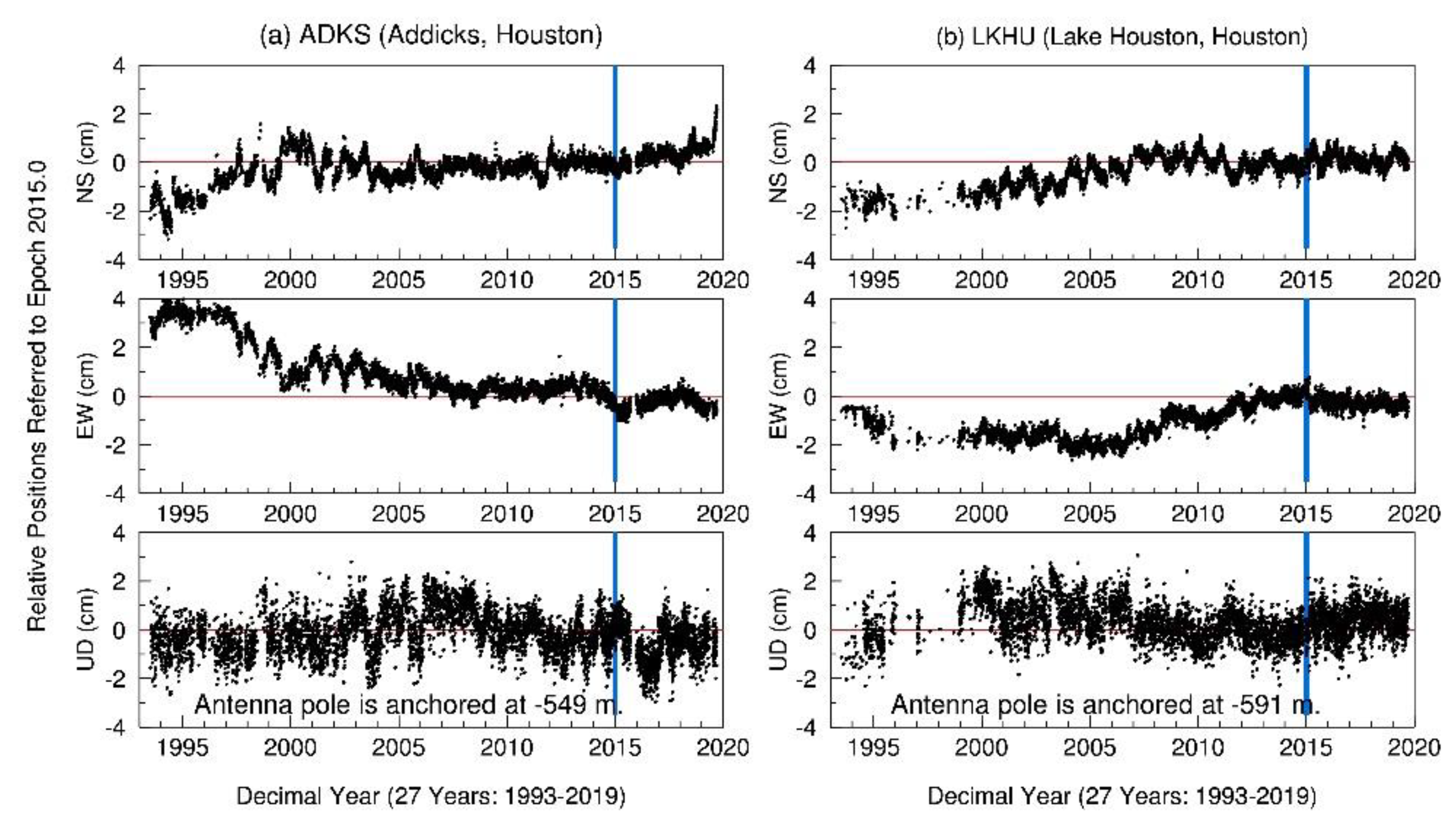
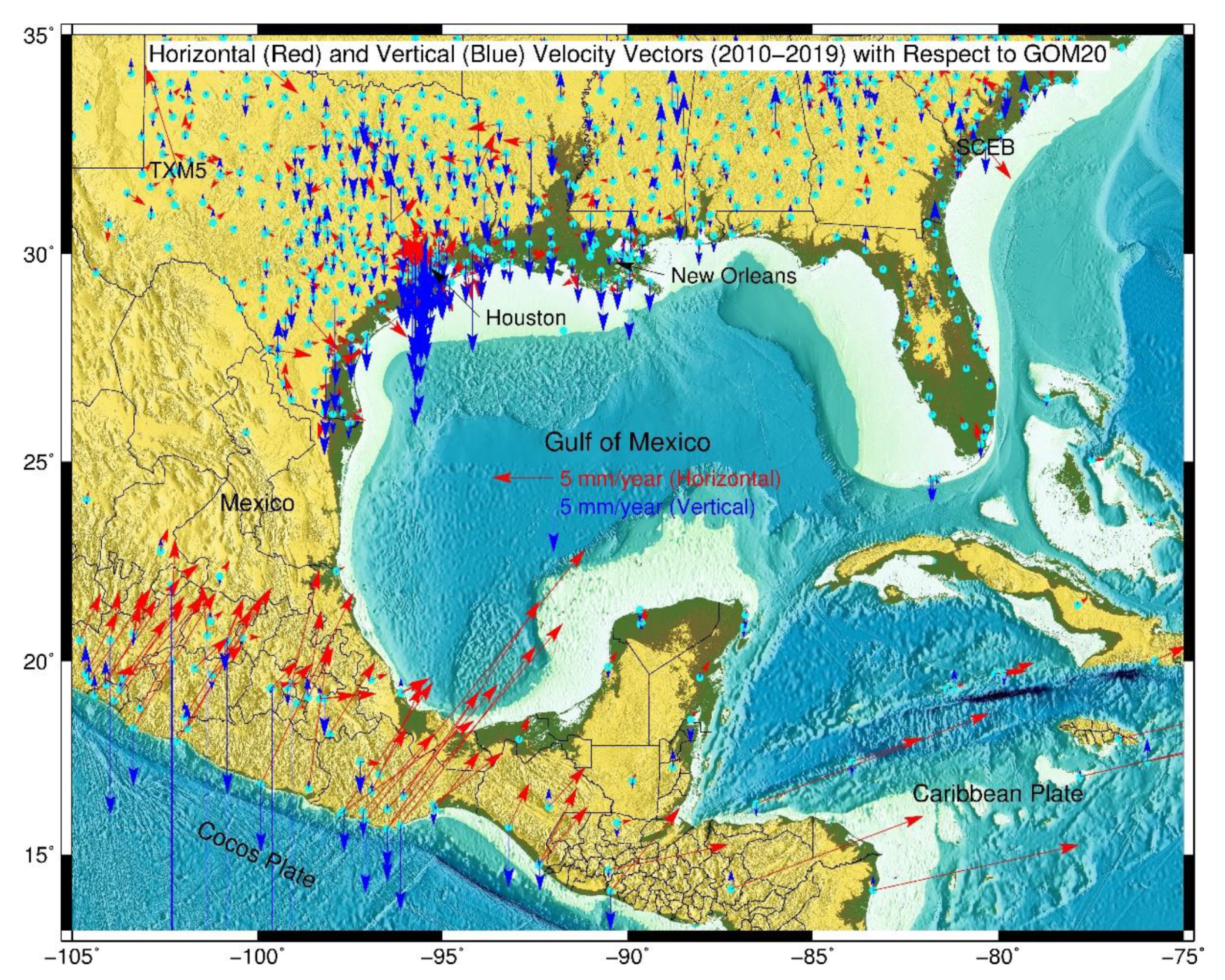
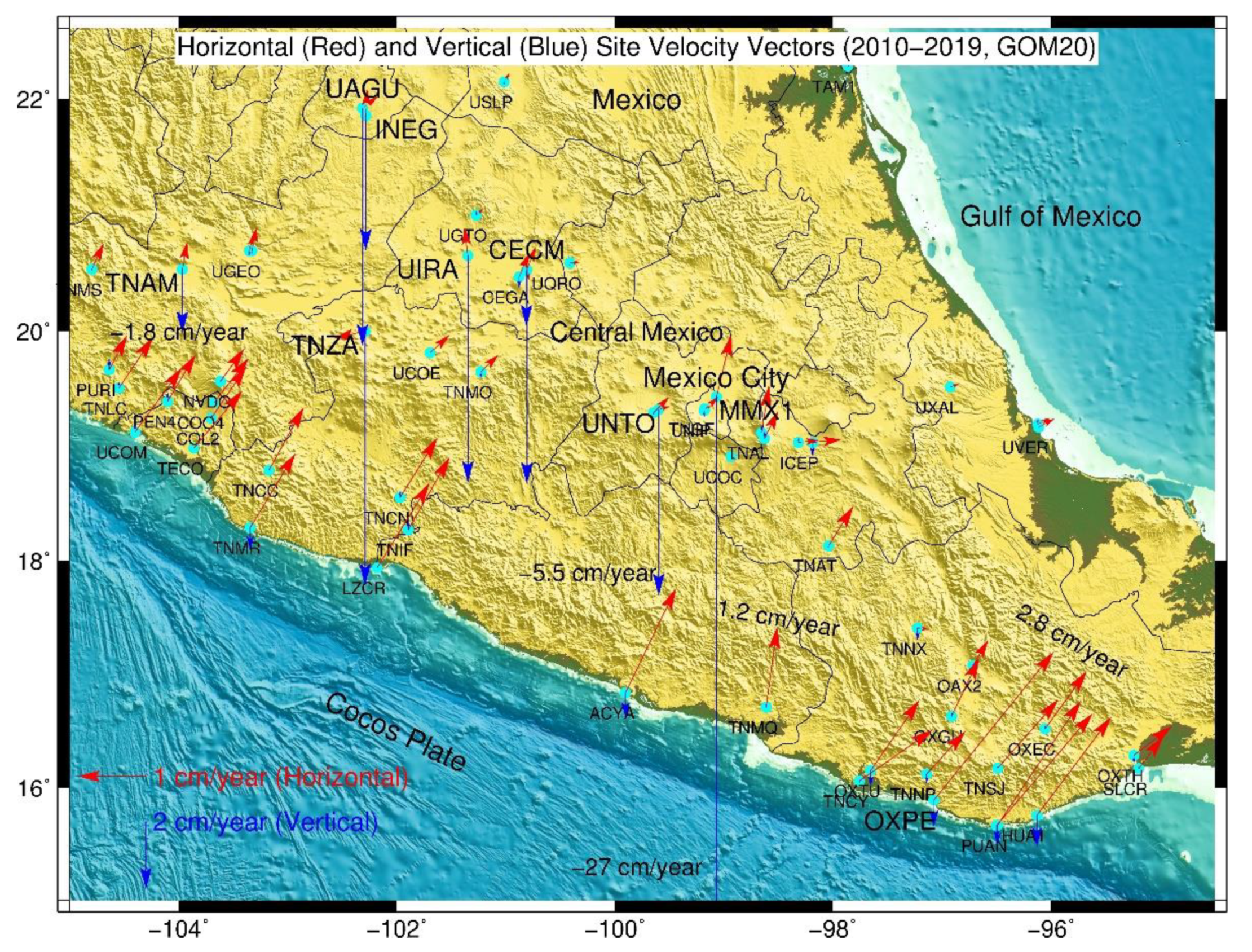
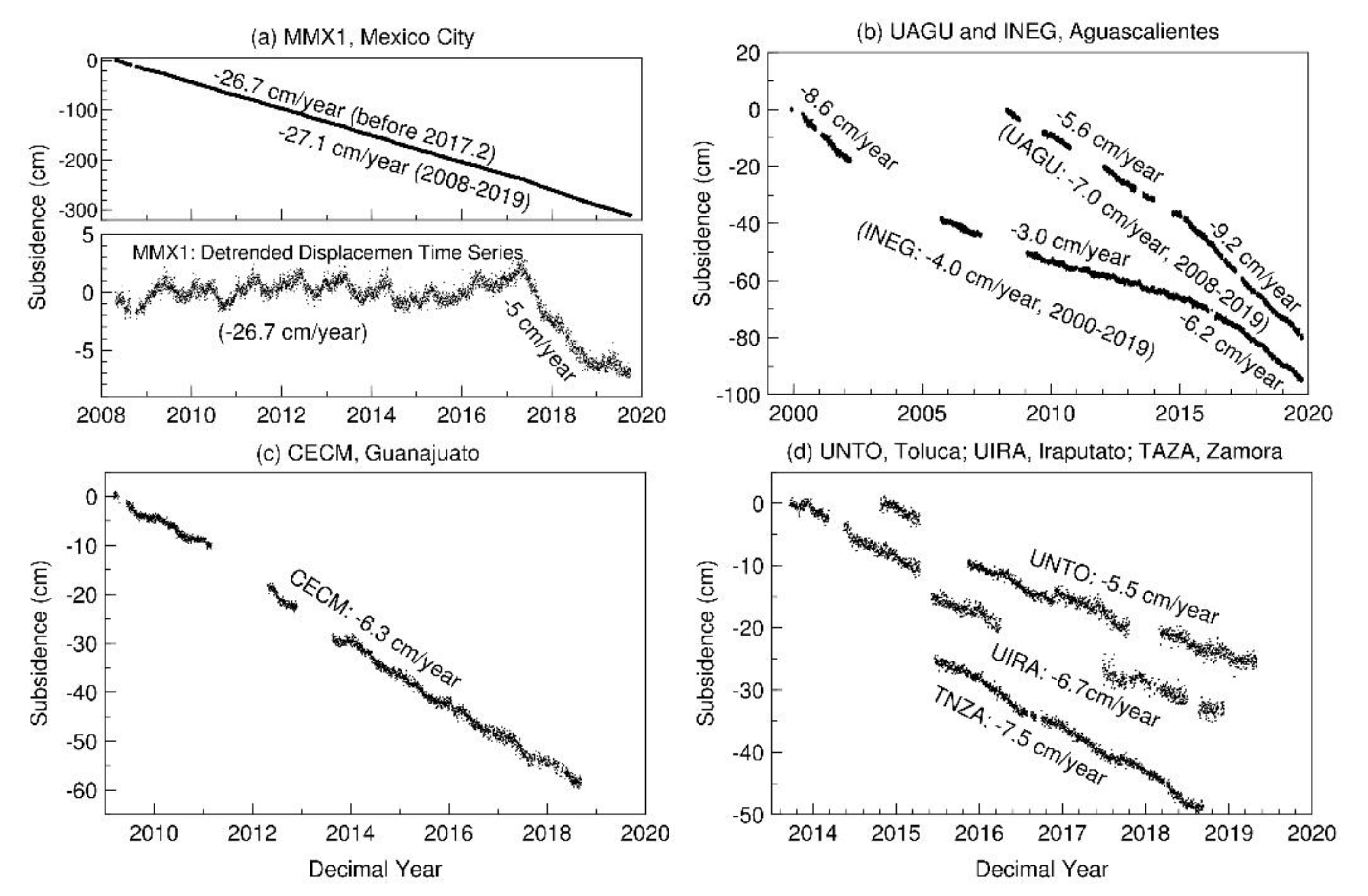
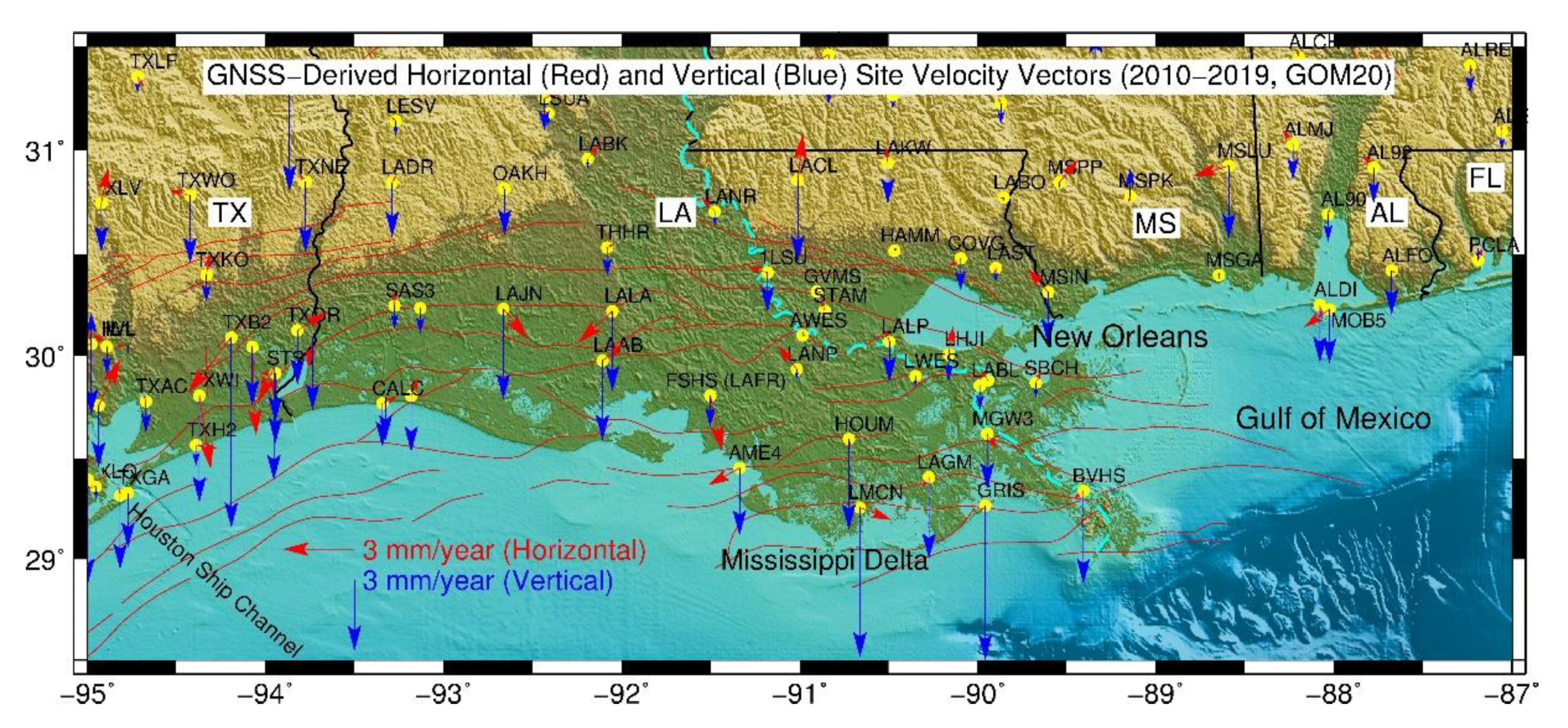
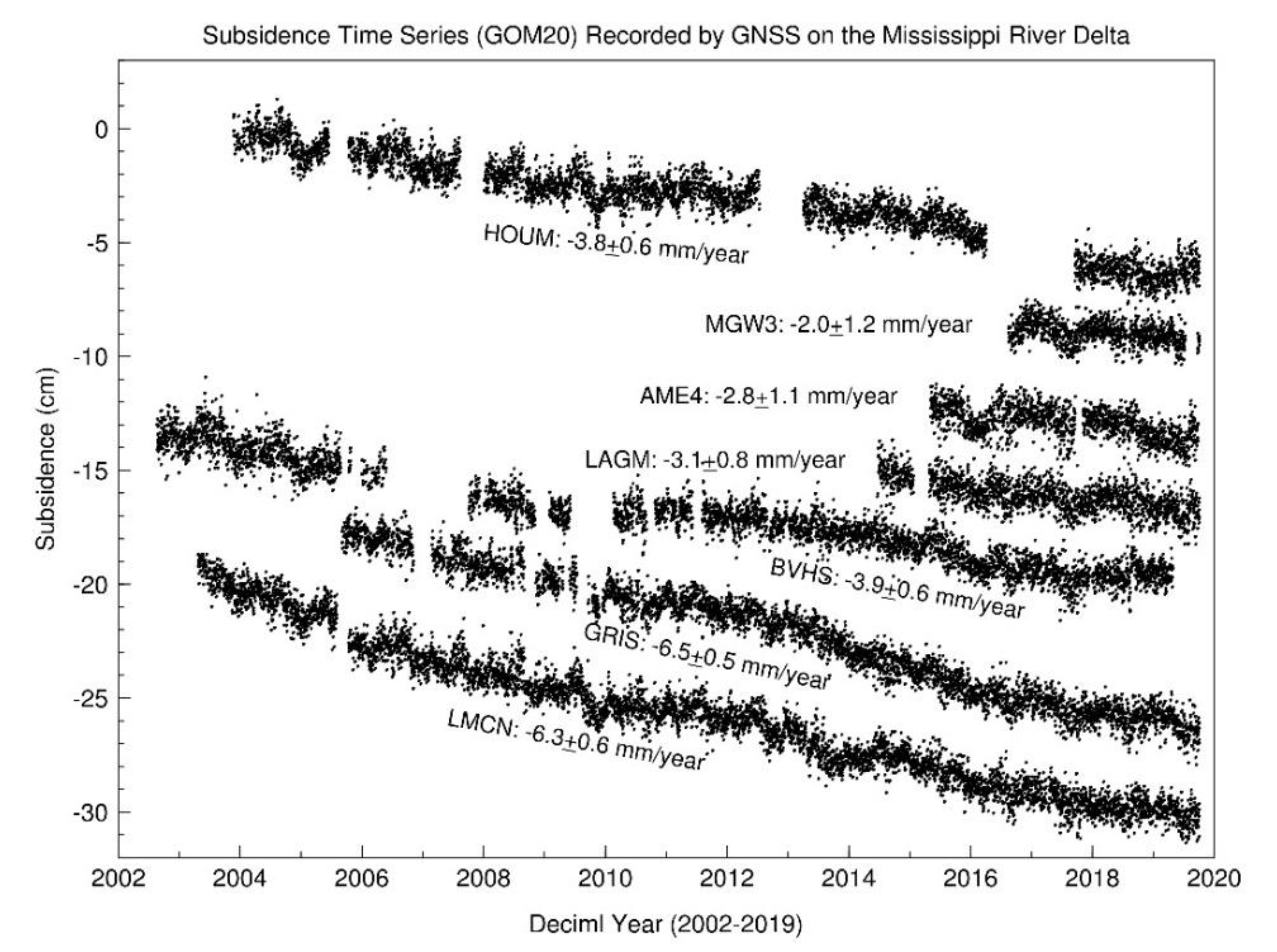
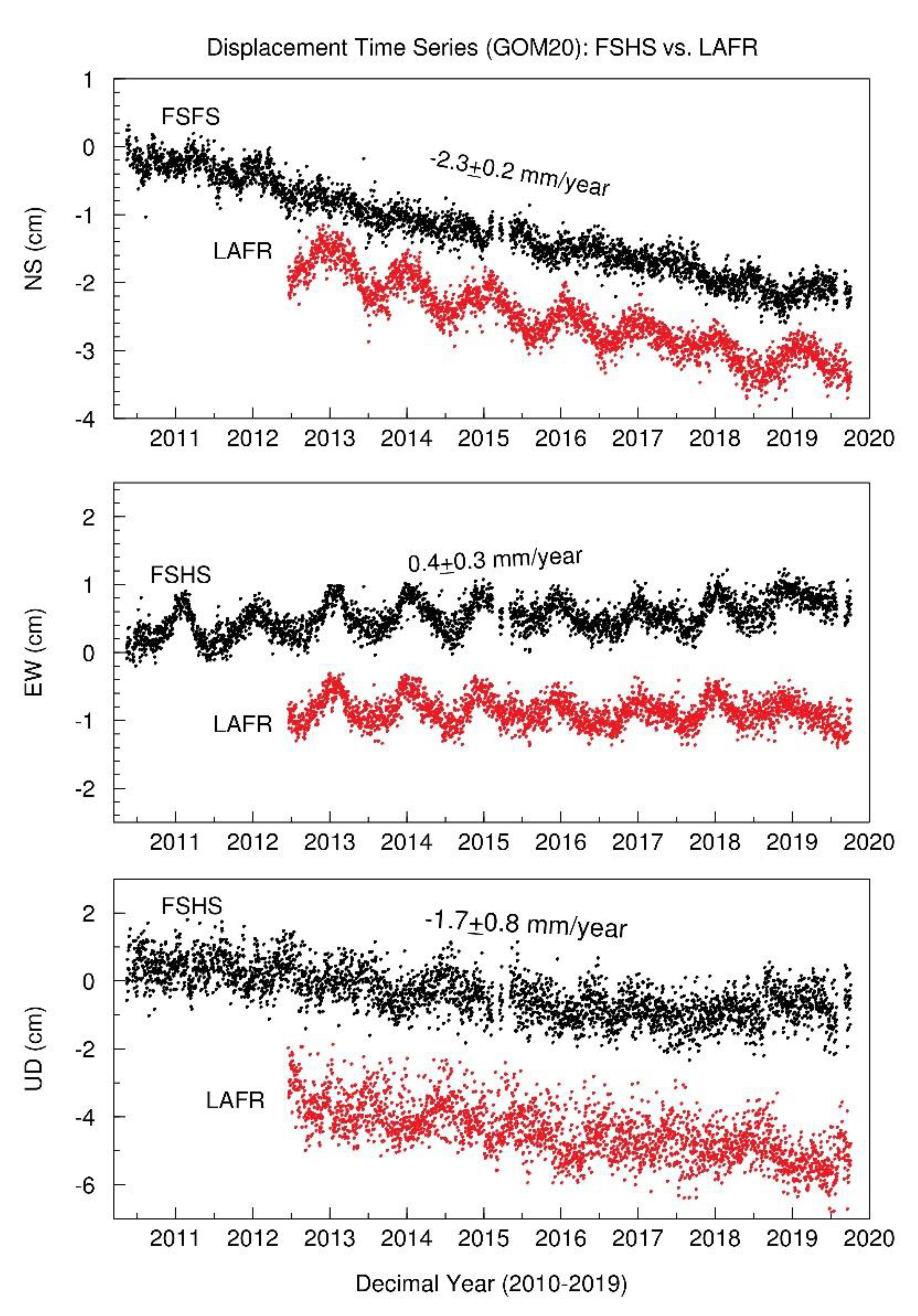
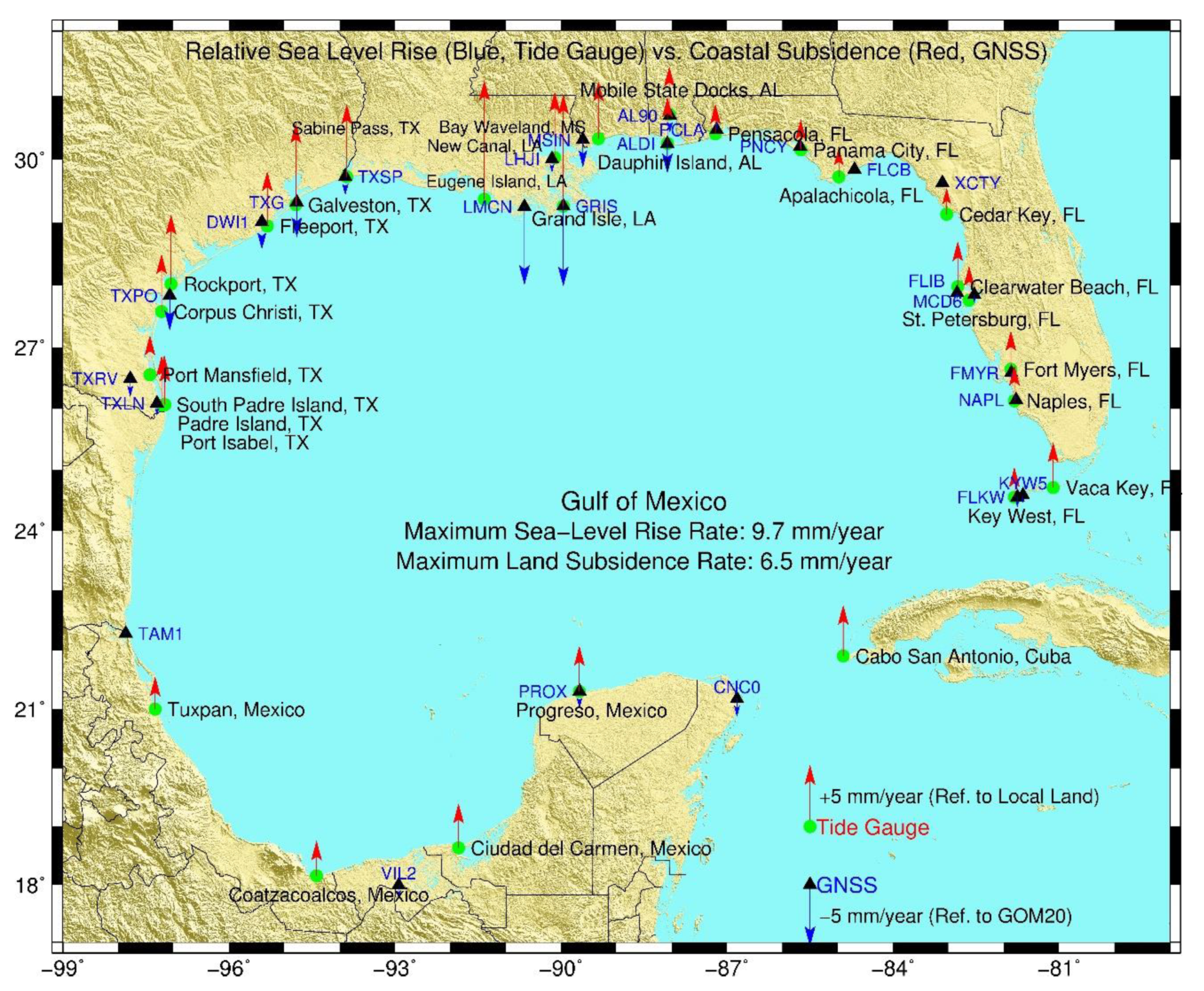
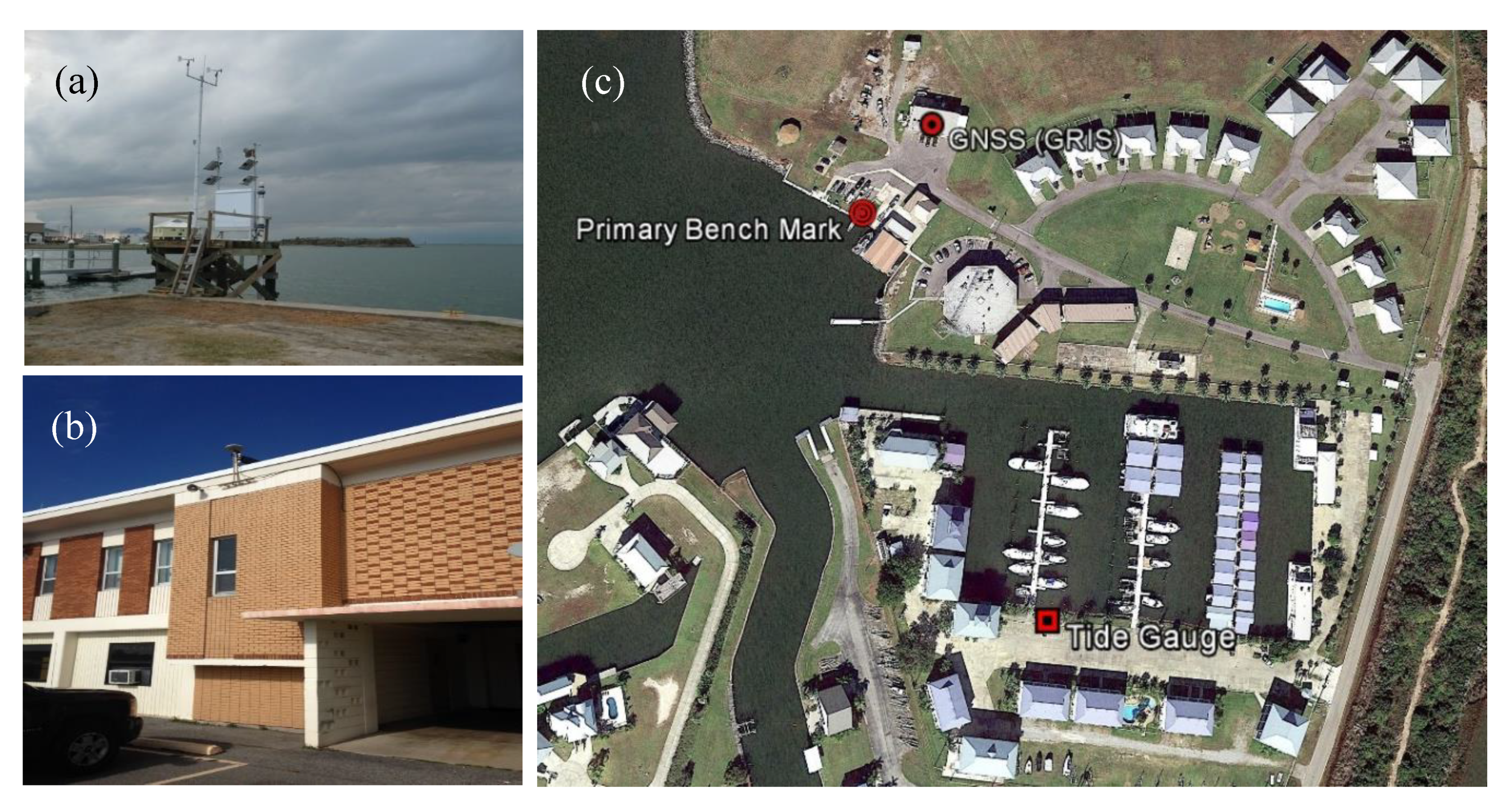
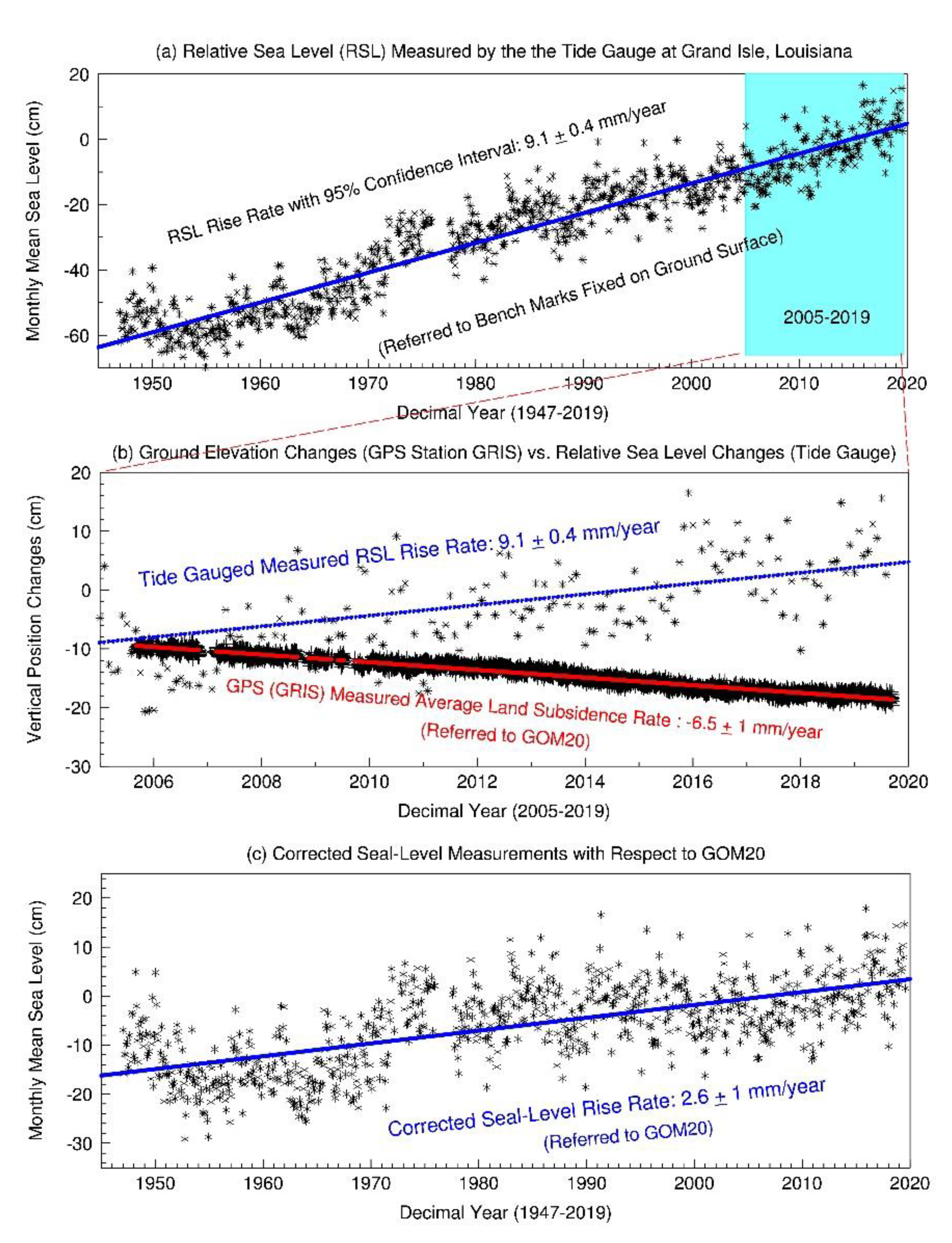
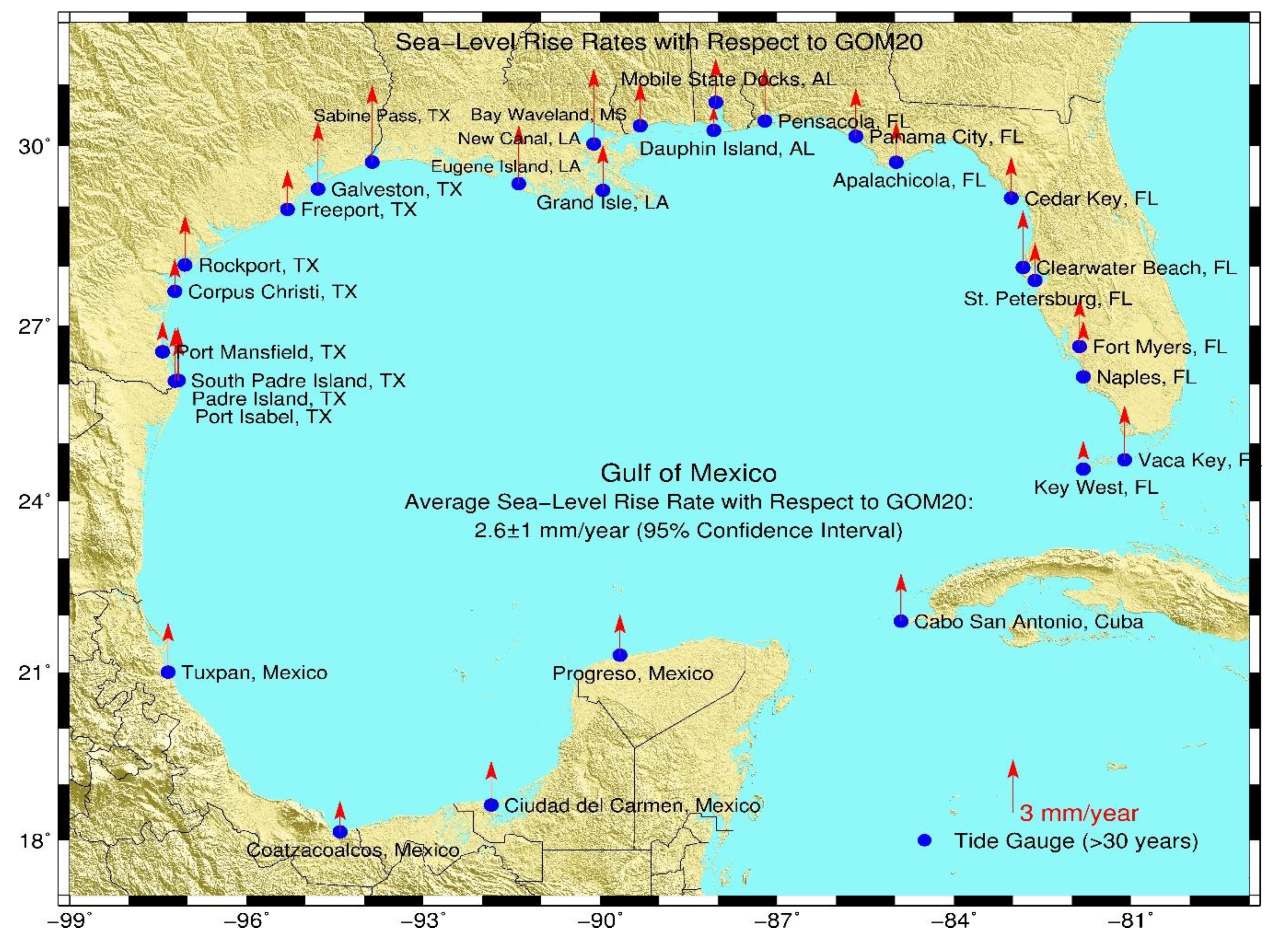
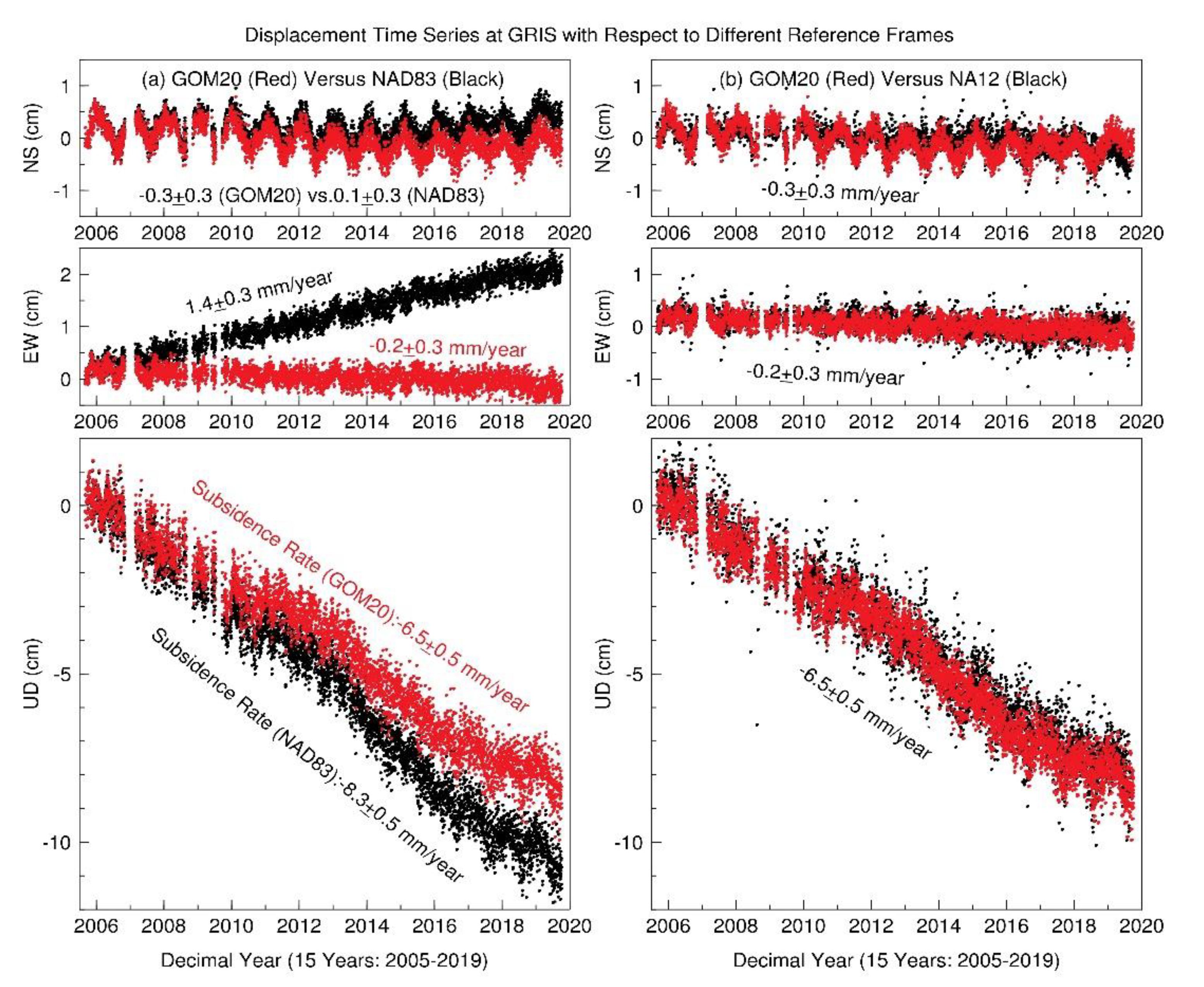
| Parameters * | Units | IGS14 to GOM20 |
|---|---|---|
| t0 | year | 2015.0 |
| T'x | m/year | 7.1281610E−004 |
| T'y | m/year | 5.6136741E−004 |
| T'z | m/year | 2.9287337E−003 |
| R'x | radian/year | −4.0941604E−010 |
| R'y | radian/year | −3.1975595E−009 |
| R'z | radian/year | −2.3610546E−010 |
| Tide Gauge Station | Closely-Spaced GNSS Station | |||||||||||||||
|---|---|---|---|---|---|---|---|---|---|---|---|---|---|---|---|---|
| Location | History (Years) | *RSLR (mm/year) | Name | Location (Degree) | History (Years) | Dis. | **VLM | ***ASLR | ||||||||
| Name | Longitude | Latitude | Start | Stop | Span | Trend | 95%CI | GNSS | Longitude | Latitude | Start | Stop | Span | (km) | (mm/year) | (mm/year) |
| Key West, FL | −81.808 | 24.551 | 1913 | 2018 | 106 | 2.42 | 0.14 | FLKW | −81.754 | 24.554 | 2002 | 2019 | 18 | 5.5 | −0.82 | 1.6 |
| Vaca Key, FL | −81.107 | 24.711 | 1971 | 2018 | 48 | 3.66 | 0.44 | KYW5 | −81.653 | 24.582 | 2009 | 2016 | 8 | 57.1 | −0.6 | 3.06 |
| Naples, FL | −81.808 | 26.132 | 1965 | 2018 | 54 | 2.85 | 0.44 | NAPL | −81.776 | 26.149 | 2003 | 2019 | 17 | 3.6 | 0.3 | 3.15 |
| Fort Myers, FL | −81.871 | 26.648 | 1965 | 2018 | 54 | 3.11 | 0.47 | FMYR | −81.864 | 26.591 | 2004 | 2019 | 16 | 6.3 | −0.4 | 2.71 |
| St. Petersburg, FL | −82.627 | 27.761 | 1947 | 2018 | 72 | 2.78 | 0.24 | MCD6 | −82.533 | 27.850 | 2001 | 2019 | 19 | 13.6 | −0.65 | 2.13 |
| Clearwater Beach, FL | −82.832 | 27.978 | 1973 | 2018 | 46 | 3.68 | 0.57 | FLIB | −82.843 | 27.880 | 2017 | 2019 | 3 | 11.0 | −0.45 | 3.23 |
| Cedar Key, FL | −83.032 | 29.135 | 1914 | 2018 | 105 | 2.13 | 0.18 | XCTY | −83.108 | 29.631 | 2004 | 2019 | 16 | 55.6 | 0.19 | 2.32 |
| Apalachicola, FL | −84.982 | 29.727 | 1967 | 2018 | 52 | 2.38 | 0.62 | FLCB | −84.695 | 29.843 | 2015 | 2019 | 5 | 30.5 | −0.11 | 2.27 |
| Panama City, FL | −85.667 | 30.152 | 1973 | 2018 | 46 | 2.43 | 0.61 | PNCY | −85.678 | 30.205 | 2002 | 2010 | 9 | 5.9 | 0.28 | 2.71 |
| Pensacola, FL | −87.211 | 30.404 | 1923 | 2018 | 96 | 2.4 | 0.23 | PCLA | −87.189 | 30.469 | 2004 | 2019 | 16 | 7.5 | 0.59 | 2.99 |
| Dauphin Island, AL | −88.075 | 30.250 | 1966 | 2018 | 53 | 3.74 | 0.58 | ALDI | −88.078 | 30.249 | 2009 | 2019 | 11 | 0.3 | −2.4 | 1.34 |
| Mobile State Docks, AL | −88.043 | 30.708 | 1980 | 2018 | 39 | 3.85 | 1.42 | AL90 | −88.032 | 30.691 | 2007 | 2019 | 13 | 2.2 | −1.38 | 2.47 |
| Bay Waveland, MS | −89.325 | 30.325 | 1978 | 2018 | 41 | 4.64 | 0.82 | MSIN | −89.604 | 30.312 | 2012 | 2019 | 8 | 26.9 | −2.2 | 2.44 |
| New Canal, LA | −90.113 | 30.027 | 1982 | 2018 | 37 | 5.35 | 1.17 | LHJI | −90.162 | 30.008 | 2012 | 2019 | 8 | 5.2 | −1.8 | 3.55 |
| Grand Isle, LA | −89.957 | 29.263 | 1947 | 2018 | 72 | 9.08 | 0.42 | GRIS | −89.957 | 29.266 | 2005 | 2019 | 15 | 0.3 | −6.52 | 2.56 |
| Eugene Island, LA | −91.385 | 29.372 | 1939 | 1974 | 36 | 9.65 | 1.24 | LMCN | −90.661 | 29.255 | 2003 | 2019 | 17 | 71.4 | −6.35 | 3.3 |
| Sabine Pass, TX | −93.870 | 29.728 | 1958 | 2018 | 61 | 5.86 | 0.74 | TXSP | −93.897 | 29.731 | 2016 | 2019 | 4 | 2.6 | −1 | 4.86 |
| Galveston Pleasure Pier, TX | −94.789 | 29.285 | 1957 | 2011 | 55 | 6.62 | 0.69 | TXGA | −94.773 | 29.328 | 2005 | 2019 | 15 | 5.0 | −2.84 | 3.78 |
| Freeport, TX | −95.308 | 28.948 | 1954 | 2008 | 37 | 4.43 | 1.05 | DWI1 | −95.404 | 29.014 | 2009 | 2019 | 11 | 11.8 | −2.21 | 2.22 |
| Rockport, TX | −97.047 | 28.022 | 1937 | 2018 | 82 | 5.62 | 0.48 | TXPO | −97.070 | 27.839 | 2010 | 2019 | 10 | 20.4 | −2.82 | 2.8 |
| Corpus Christi, TX | −97.217 | 27.580 | 1983 | 2018 | 36 | 4.65 | 1.06 | TXPO | −97.070 | 27.839 | 2010 | 2019 | 10 | 32.3 | −2.82 | 1.83 |
| Port Mansfield, TX | −97.426 | 26.558 | 1963 | 2018 | 56 | 3.19 | 0.73 | TXRV | −97.781 | 26.494 | 2013 | 2019 | 7 | 36.0 | −1.47 | 1.72 |
| South Padre Island, TX | −97.168 | 26.073 | 1958 | 2018 | 61 | 4 | 0.69 | TXLN | −97.301 | 26.095 | 2013 | 2019 | 7 | 13.5 | −1.02 | 2.98 |
| Padre Island, TX | −97.157 | 26.068 | 1958 | 2006 | 49 | 3.48 | 0.75 | TXLN | −97.301 | 26.095 | 2013 | 2019 | 7 | 14.7 | −1.02 | 2.46 |
| Port Isabel, TX | −97.216 | 26.061 | 1944 | 2018 | 75 | 4 | 0.33 | TXLN | −97.301 | 26.095 | 2013 | 2019 | 7 | 9.3 | −1.02 | 2.98 |
| Tuxpan, Mexico | −97.333 | 21.000 | 1958 | 1990 | 33 | 2.64 | 1.45 | TAM1 | −97.864 | 22.278 | 2009 | 2019 | 11 | 152.4 | 0.16 | 2.8 |
| Coatzacoalcos, Mexico | −94.417 | 18.150 | 1952 | 1987 | 36 | 2.86 | 1.06 | VIL2 | −92.931 | 17.990 | 2003 | 2019 | 17 | 158.0 | −1.1 | 1.76 |
| Ciudad del Carmen, Mexico | −91.850 | 18.633 | 1956 | 1988 | 33 | 3.6 | 0.94 | VIL2 | −92.931 | 17.990 | 2003 | 2019 | 17 | 134.7 | −1.1 | 2.5 |
| Progreso, Mexico | −89.667 | 21.300 | 1952 | 2013 | 62 | 3.69 | 0.78 | PROX | −89.667 | 21.303 | 2011 | 2015 | 5 | 0.4 | −1.38 | 2.31 |
| Cabo San Antonio, Cuba | −84.900 | 21.900 | 1971 | 2016 | 46 | 4.12 | 1.06 | CNC0 | −86.821 | 21.175 | 2007 | 2019 | 13 | 214.4 | −1.42 | 2.7 |
| Average: | 56 | 11 | 2.6 | |||||||||||||
© 2020 by the authors. Licensee MDPI, Basel, Switzerland. This article is an open access article distributed under the terms and conditions of the Creative Commons Attribution (CC BY) license (http://creativecommons.org/licenses/by/4.0/).
Share and Cite
Wang, G.; Zhou, X.; Wang, K.; Ke, X.; Zhang, Y.; Zhao, R.; Bao, Y. GOM20: A Stable Geodetic Reference Frame for Subsidence, Faulting, and Sea-Level Rise Studies along the Coast of the Gulf of Mexico. Remote Sens. 2020, 12, 350. https://doi.org/10.3390/rs12030350
Wang G, Zhou X, Wang K, Ke X, Zhang Y, Zhao R, Bao Y. GOM20: A Stable Geodetic Reference Frame for Subsidence, Faulting, and Sea-Level Rise Studies along the Coast of the Gulf of Mexico. Remote Sensing. 2020; 12(3):350. https://doi.org/10.3390/rs12030350
Chicago/Turabian StyleWang, Guoquan, Xin Zhou, Kuan Wang, Xue Ke, Yongwei Zhang, Ruibin Zhao, and Yan Bao. 2020. "GOM20: A Stable Geodetic Reference Frame for Subsidence, Faulting, and Sea-Level Rise Studies along the Coast of the Gulf of Mexico" Remote Sensing 12, no. 3: 350. https://doi.org/10.3390/rs12030350
APA StyleWang, G., Zhou, X., Wang, K., Ke, X., Zhang, Y., Zhao, R., & Bao, Y. (2020). GOM20: A Stable Geodetic Reference Frame for Subsidence, Faulting, and Sea-Level Rise Studies along the Coast of the Gulf of Mexico. Remote Sensing, 12(3), 350. https://doi.org/10.3390/rs12030350





